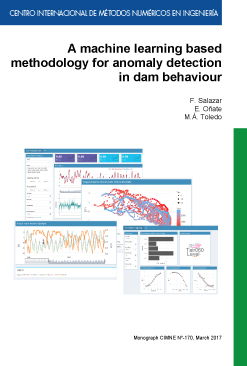A machine learning based methodology for anomaly detection in dam behaviour
FREE!
Editorial: CIMNE
Year of publication: 2017
Pages: 250
Index: List of Figures; List of Tables; Nomenclature; 1. Introduction and Objectives; 2. State of the art review; 3. Algorithm Selection; 4. Model Interpretation; 5. Anomaly detection; 6. Achievements, Conclusions and Future Research Lines; Appendices
Editorial: CIMNE
Year of publication: 2017
Pages: 250
Index: List of Figures; List of Tables; Nomenclature; 1. Introduction and Objectives; 2. State of the art review; 3. Algorithm Selection; 4. Model Interpretation; 5. Anomaly detection; 6. Achievements, Conclusions and Future Research Lines; Appendices
Description
Dam behaviour is difficult to predict with high accuracy. Numerical models for structural calculation solve the equations of continuum mechanics, but are subject to considerable uncertainty as to the characterisation of materials, especially with regard to the foundation. As a result, these models are often incapable to calculate dam behaviour with sufficient precision. Thus, it is difficult to determine whether a given deviation between model results and monitoring data represent a relevant anomaly or incipient failure.
By contrast, there is a tendency towards automatising dam monitoring devices, which allows for increasing the reading frequency and results in a greater amount and variety of data available, such as displacements, leakage, or interstitial pressure, among others.
This increasing volume of dam monitoring data makes it interesting to study the ability of advanced tools to extract useful information from observed variables.
In particular, in the field of Machine Learning (ML), powerful algorithms have been developed to face problems where the amount of data is much larger or the underlying phenomena is much less understood.
In this monograph, the possibilities of machine learning techniques are analysed for application to dam structural analysis based on monitoring data. The typical characteristics of the data sets available in dam safety are taking into account, as regards their nature, quality and size.
A critical literature review is performed, from which the key issues to consider for implementation of these algorithms in dam safety are identified.
A comparative study of the accuracy of a set of algorithms for predicting dam behaviour is carried out, considering radial and tangential displacements and leakage flow in a 100-m high dam. The results suggest that the algorithm called Boosted Regression Trees (BRT) is the most suitable, being more accurate in general, while flexible and relatively easy to implement.
The possibilities of interpretation of the mentioned algorithm are evaluated, to identify the shape and intensity of the association between external variables and the dam response, as well as the effect of time. The tools are applied to the same test case, and allow more accurate identification of the time effect than the traditional statistical method.
Finally, a methodology for the implementation of predictive models based on BRT for early detection of anomalies is presented, together with its implementation in an interactive tool that provides information on dam behaviour, through a set of selected devices. It allows the user to easily verify whether the actual data for each of these devices are within a pre-defined normal operation interval.

